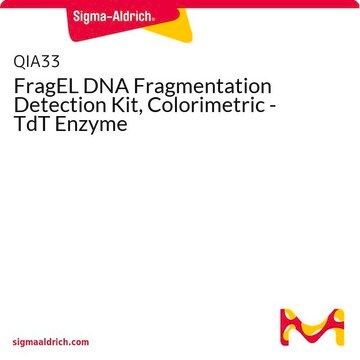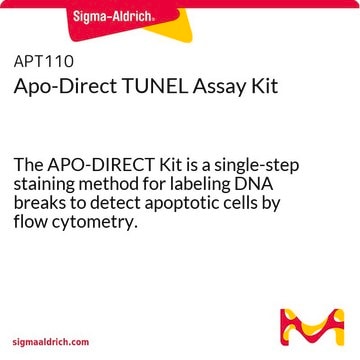11835246001
Roche
Apoptotic DNA-Ladder Kit
Sinônimo(s):
DNA ladder
About This Item
Produtos recomendados
uso
sufficient for ≤20 tests
fabricante/nome comercial
Roche
temperatura de armazenamento
20-25°C
Descrição geral
The study of cell death involves characterizing mortality as apoptotic or necrotic. Apoptosis can be characterized by:
- Prelytic, non-random fragmentation of DNA (“ladder” pattern after agarose-gel electrophoresis)1
- Formation of membrane-bound vesicles (or “apoptotic bodies”)
- Cell shrinkage due to a concentration of cytoplasm
Similarly, necrosis (or physiological cell death) is characterized by
- Random digestion of DNA (DNA smear after agarose-gel electrophoresis)
- Swollen organelles and cells, resulting from loss of membrane integrity and cell lysis
- Postlytic DNA fragmentation
As these differences indicate, the classification of cell death can be accomplished through observing cell morphology, or less subjectively, by analyzing genomic DNA. Resolving the DNA on a gel provides a quick and documentable form of data to differentiate between apoptosis and necrosis.
Especificidade
Aplicação
Embalagem
Princípio
Nota de preparo
Preparation of Working Solutions
- Add 80 ml ethanol, analysis grade, to Washing Buffer
- Dissolve Positive Control (violet cap) in 400 μl Binding/Lysis Buffer and mix immediately.
- Incubate for 10 minutes at 15 to 25 °C.
EDTA solution (0.5 M)
Dissolve 18.6 g EDTA in 80 ml double dist. water and stir. Adjust pH 8.0 ± 0.1 with 1 M NaOH. EDTA solubilizes at alkaline pH only. After solubilization fill up to 100 ml with double dist. water.
TBE-Buffer
Dissolve 5.4 g Tris, 2.8 g Boric acid in 800 ml double dist. water and add 2 ml
of 0.5 M EDTA solution . Stir until dissolved, final pH 8.0 ± 0.1. Fill up to 1 liter with double dist. water.
Ethidium bromide stock solution
Dissolve 50 mg ethidium bromide in 5 ml double dist. water (ethidium bromide is a mutagen and potential carcinogen; gloves should be worn and care should be taken when handling ethidium bromide solutions).
Alternatively SYBR Green I Nucleic Acid Gel Stain can be used instead of Ethidium bromide.
Loading Buffer (10x)
Dissolve 0.1 g sodium dodecyl sulfate, 25 mg Bromophenol Blue in 7 ml double dist. water and add 3 ml glycerol
Storage conditions (working solution): The positive control can be used for 14 days after preparation, when storing the isolated control DNA at -15 to -25 °C.
Outras notas
Informações legais
Somente componentes do kit
- Binding/Lysis Buffer
- Washing Buffer
- Elution Buffer
- Polypropylene Tubes, contain two layers of glass fiber fleece and can hold up to 700 μl sample volume
- Polypropylene Collection Tubes
- Control Apoptotic U937 Cells, lyophilized
Palavra indicadora
Danger
Frases de perigo
Declarações de precaução
Classificações de perigo
Acute Tox. 4 Oral - Aquatic Chronic 3 - Eye Dam. 1 - Skin Irrit. 2
Código de classe de armazenamento
12 - Non Combustible Liquids
Classe de risco de água (WGK)
WGK 2
Ponto de fulgor (°F)
does not flash
Ponto de fulgor (°C)
does not flash
Escolha uma das versões mais recentes:
Já possui este produto?
Encontre a documentação dos produtos que você adquiriu recentemente na biblioteca de documentos.
Os clientes também visualizaram
Artigos
Cellular apoptosis assays to detect programmed cell death using Annexin V, Caspase and TUNEL DNA fragmentation assays.
Nossa equipe de cientistas tem experiência em todas as áreas de pesquisa, incluindo Life Sciences, ciência de materiais, síntese química, cromatografia, química analítica e muitas outras.
Entre em contato com a assistência técnica












